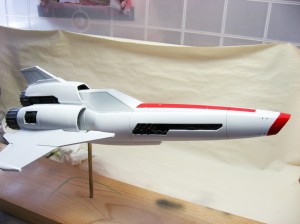 The Viper model kit comes with an extensive decal sheet, which included all of the red striping that dominate this craft. I, however, am using the Aztek Dummy masks. In the first photo below you see the sheet the masks come from, with the odd angled pieces already removed – the black vinyl is the mask, the visible white is the backing. The next photo shows it on top of the wing. Those black strips/bars that connect the two sides of the mask are there to aid in placement. After placement you take a straight-edge and a knife and cut them free. In my opinion this causes a major problem, which is why I started by trying these out on the lower wing surfaces first. By cutting the reinforcing strips out after putting them on the model, you are cutting a small groove into the wing’s surface. Also, you have to be precise, very precise, to make sure that cut is exactly along the edge or you get a recess or protrusion in your straight-line mask. I ran into issues with all of this, and while the result is okay, the cuts where I removed the reinforcements pulled paint into them causing artifacts in the finish (and I cut the reinforcements out with a brand new, super sharp, scalpel blade). In the final photo of this set you can see the end result. They look okay in the photo, but up close there’s too much inconsistency for my liking. The large white chips in the red are intentional, more on how I do those in a moment.
The Viper model kit comes with an extensive decal sheet, which included all of the red striping that dominate this craft. I, however, am using the Aztek Dummy masks. In the first photo below you see the sheet the masks come from, with the odd angled pieces already removed – the black vinyl is the mask, the visible white is the backing. The next photo shows it on top of the wing. Those black strips/bars that connect the two sides of the mask are there to aid in placement. After placement you take a straight-edge and a knife and cut them free. In my opinion this causes a major problem, which is why I started by trying these out on the lower wing surfaces first. By cutting the reinforcing strips out after putting them on the model, you are cutting a small groove into the wing’s surface. Also, you have to be precise, very precise, to make sure that cut is exactly along the edge or you get a recess or protrusion in your straight-line mask. I ran into issues with all of this, and while the result is okay, the cuts where I removed the reinforcements pulled paint into them causing artifacts in the finish (and I cut the reinforcements out with a brand new, super sharp, scalpel blade). In the final photo of this set you can see the end result. They look okay in the photo, but up close there’s too much inconsistency for my liking. The large white chips in the red are intentional, more on how I do those in a moment.
I decided to skip the vinyl masks and go old-school on the nose stripes. I made a color copy of the decal sheet, cut the stripes out, and tacked them onto the model with tape. I then outlined the stripes with 6mm wide Tamiya tape for the upper stripe, and I used extra-fine 1mm wide Aizu brand tape to mask the curve around the nose.
Once the stripes were masked, I prepared a small dish of water and another dish of Kosher salt. Kosher salt has much more random and natural crystals than table salt, which makes it better for this application. Take a paint brush, put a single drop of water on the model where you want a chip. Wipe the brush on a cloth until it’s nearly completely dry, then dip it into the salt and pick up a few crystals. Put the salt on the drop of water on the model. As the water evaporates the salt dissolves just enough to adhere to the paint. Let it dry completely — usually only five or ten minutes — then spray your paint. After you remove all of the masking, take a toothpick and gently knock the salt free. Instant jagged paint chips. I’m going very light with this effect on this model, but I do like the results so far.
For the red color I’m using Mr. Color #68 “Red Madder” and I’m not entirely sold on it’s accuracy. It’s better than their #3 plain-ol’ “Red” in matching the decals, but it’s still a little bright for my tastes (and in the photos it’s much brighter than in person). Nothing that some weathering won’t tone down, though. For the stripes on the wing upper surfaces I’ll be skipping the pre-cut masks and just cut them in on my own with masking tape. I hope to have that done by the end of next weekend.
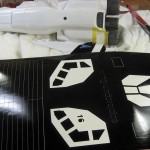
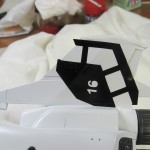
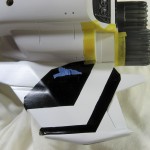
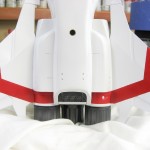
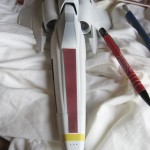
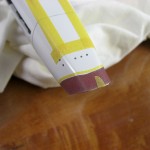
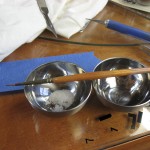
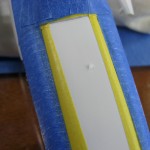
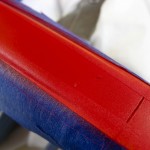
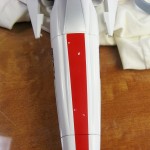
Awesome! I can’t believe how you do the salt trick….insane. The red is a bit bright, but like you said, weathering is an easy fix for that. The red in the mask is a closer red, I think.
It’s almost ready for the launch tube!
The red in the mask is actually MUCH darker than that of the decals, which I think a bit light. The paint pretty much splits the difference and is a mid-tone between those two extremes. My way of thinking is that the colors are taken from the original series Galactica filming miniatures, which would have used the old Floquil railroad colors red (like the X-Wings in Star Wars) and this shade is pretty darn close to that. After I flat coat her and start with the pastels, though, the tone will subdue quite a bit.
………okay, how in the world do you know that about the filming miniatures? And HOW do you know a red called “old Floquil railroad”? I’m astounded by the details you know…you should be a history teacher as well with a mind like yours. 😀
Over on the RPF I read all the history of the Star Wars filming miniatures, and since ILM did the original Galactica ships, and the Vipers have a similar paint scheme to the X-Wing, I assume the colors were the same. Floquil paints were their preferences, so you’re dealing with Caboose Red, etc. for the colors.
I came over to tell you how cool the salt trick was and now I get to geek out about the details of the original paint. Win!
Thanks. The one thing I always forget, though, is that the colors they painted the models doesn’t really matter, it’s how they looked on film. The red I painted still has a little too much orange in it for my liking. So tonight I’ll do what I should have done in the first place: spray a test styrene sheet with white, then add a stripe or two, and see how they tone-down after weathering. If it doesn’t turn out to my liking, then I’ll be re-masking and painting a red with a different hue; it’d be a pain and a lot of lost time, but I’d rather have it ‘done right’ than just ‘done’.
With that attitude you could never work in the phone company.
I’ll take that as a compliment!